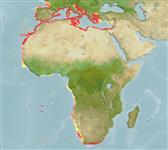>
Eupercaria/misc (Various families in series Eupercaria) >
Sparidae (Porgies)
Etymology: Diplodus: Greek, diploos = twice + Greek, odous = teeth (Ref. 45335).
More on author: Lowe.
Environment: milieu / climate zone / rango de profundidad / distribution range
Ecología
marino asociado a arrecife; oceanodromo (Ref. 51243); rango de profundidad 30 - 300 m (Ref. 3688). Subtropical; 47°N - 35°S, 19°W - 36°E
Eastern Atlantic: Bay of Biscay and the Mediterranean to the Strait of Gibraltar and South Africa including Madeira and the Canary islands, but absent from Cape Verde, off Senegal and the Gulf of Guinea.
Length at first maturity / Tamaño / Peso / Age
Madurez: Lm 27.3, range 22 - ? cm
Max length : 55.0 cm TL macho / no sexado; (Ref. 2715); common length : 35.0 cm TL macho / no sexado; (Ref. 2715); peso máximo publicado: 2.7 kg (Ref. 40637)
Benthopelagic on the shelf, on rocky bottoms from 30 to 80 m depth, but may also occur down to 300 m on muddy bottoms. Forms schools of 4 or 5 individuals of different sizes. Omnivorous, feeds on small invertebrates and seaweeds (Ref. 4781).
Life cycle and mating behavior
Madurez | Reproducción | Puesta | Huevos | Fecundidad | Larva
Bauchot, M.-L. and J.-C. Hureau, 1990. Sparidae. p. 790-812. In J.C. Quero, J.C. Hureau, C. Karrer, A. Post and L. Saldanha (eds.) Check-list of the fishes of the eastern tropical Atlantic (CLOFETA). JNICT, Lisbon; SEI, Paris; and UNESCO, Paris. Vol. 2. (Ref. 3688)
IUCN Red List Status (Ref. 130435: Version 2025-1)
Threat to humans
Harmless
Human uses
Pesquerías: escaso valor comercial; pesca deportiva: si
Herramientas
Special reports
Download XML
Fuentes de Internet
Estimates based on models
Preferred temperature (Referencia
123201): 13.3 - 17.9, mean 14.9 °C (based on 141 cells).
Phylogenetic diversity index (Referencia
82804): PD
50 = 0.5000 [Uniqueness, from 0.5 = low to 2.0 = high].
Bayesian length-weight: a=0.01122 (0.00717 - 0.01756), b=3.07 (2.94 - 3.20), in cm total length, based on LWR estimates for this species & Genus-body shape (Ref.
93245).
Nivel trófico (Referencia
69278): 3.0 ±0.37 se; based on food items.
Resiliencia (Referencia
120179): Bajo, población duplicada en un tiempo mínimo de 4.5-14 años (Preliminary K or Fecundity.).
Fishing Vulnerability (Ref.
59153): Moderate to high vulnerability (55 of 100).
🛈
Climate Vulnerability (Ref.
125649): Low to moderate vulnerability (26 of 100).
🛈
Nutrients (Ref.
124155): Calcium = 25 [11, 41] mg/100g; Iron = 0.555 [0.295, 1.054] mg/100g; Protein = 20.1 [19.0, 21.2] %; Omega3 = 0.226 [0.116, 0.462] g/100g; Selenium = 22.8 [10.8, 41.7] μg/100g; VitaminA = 38.1 [11.0, 125.1] μg/100g; Zinc = 0.786 [0.517, 1.182] mg/100g (wet weight);
